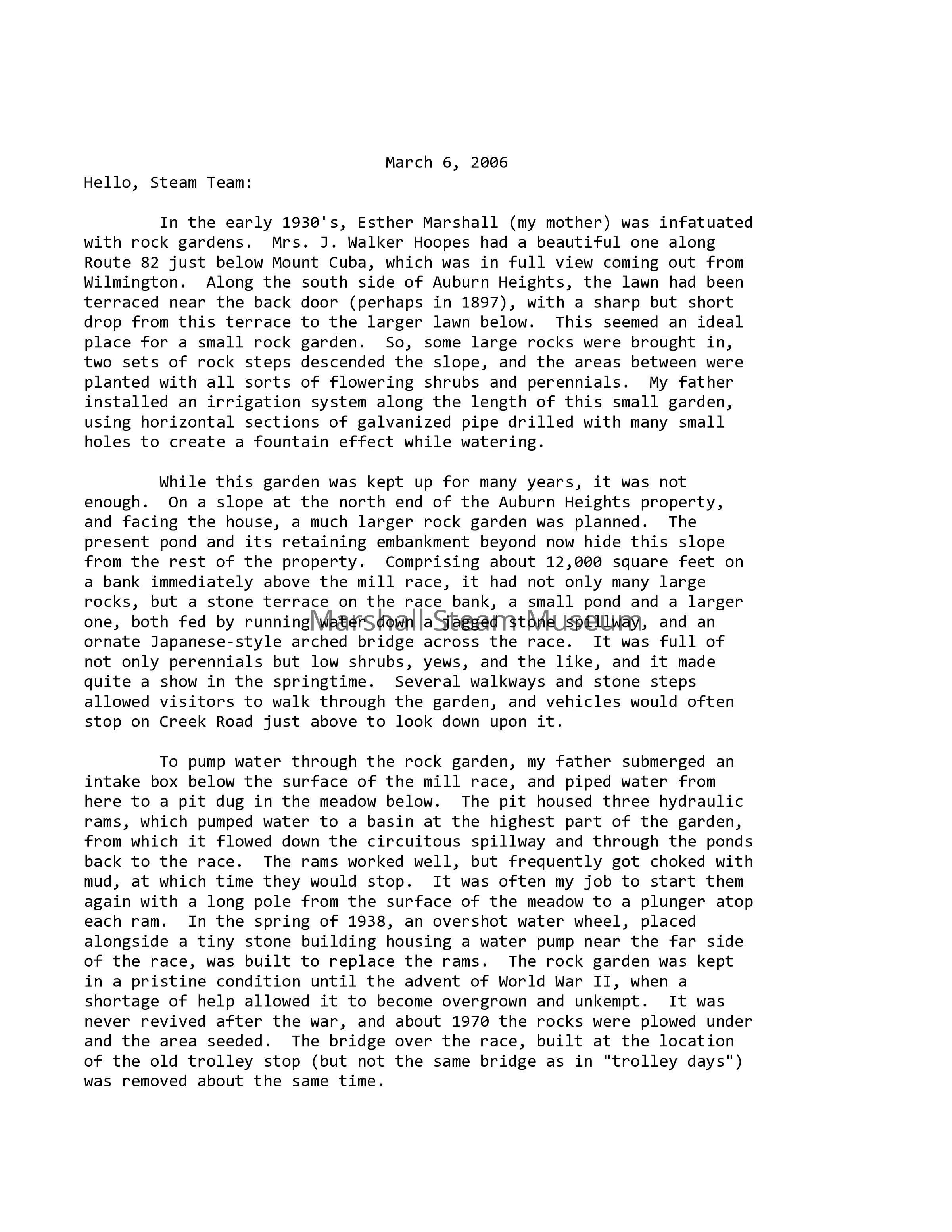Title
Weekly News March 6, 2006Description
In the early 1930's, Esther Marshall (my mother) was infatuated with rock gardens. Mrs. J. Walker Hoopes had a beautiful one along Route 82 just below Mount Cuba, which was in full view coming out from Wilmington. Along the south side of Auburn Heights, the lawn had been terraced near the back door (perhaps in 1897), with a sharp but short drop from this terrace to the larger lawn below. This seemed an ideal place for a small rock garden. So, some large rocks were brought in, two sets of rock steps descended the slope, and the areas between were planted with all sorts of flowering shrubs and perennials. My father installed an irrigation system along the length of this small garden, using horizontal sections of galvanized pipe drilled with many small holes to create a fountain effect while watering.
While this garden was kept up for many years, it was not enough. On a slope at the north end of the Auburn Heights property, and facing the house, a much larger rock garden was planned. The present pond and its retaining embankment beyond now hide this slope from the rest of the property. Comprising about 12,000 square feet on a bank immediately above the mill race, it had not only many large rocks, but a stone terrace on the race bank, a small pond and a larger one, both fed by running water down a jagged stone spillway, and an ornate Japanese-style arched bridge across the race. It was full of not only perennials but low shrubs, yews, and the like, and it made quite a show in the springtime. Several walkways and stone steps allowed visitors to walk through the garden, and vehicles would often stop on Creek Road just above to look down upon it.
To pump water through the rock garden, my father submerged an intake box below the surface of the mill race, and piped water from here to a pit dug in the meadow below. The pit housed three hydraulic rams, which pumped water to a basin at the highest part of the garden, from which it flowed down the circuitous spillway and through the ponds back to the race. The rams worked well, but frequently got choked with mud, at which time they would stop. It was often my job to start them again with a long pole from the surface of the meadow to a plunger atop each ram. In the spring of 1938, an overshot water wheel, placed alongside a tiny stone building housing a water pump near the far side of the race, was built to replace the rams. The rock garden was kept in a pristine condition until the advent of World War II, when a shortage of help allowed it to become overgrown and unkempt. It was never revived after the war, and about 1970 the rocks were plowed under and the area seeded. The bridge over the race, built at the location of the old trolley stop (but not the same bridge as in "trolley days") was removed about the same time.
Don't forget our upcoming bus trip to the B & O Railroad Museum in Baltimore on Saturday, April 1. Rob Robison tells us that he still has space available, but the deadline is getting close, so please get in touch with him if you can go. It will be a great day. Transportation from Auburn Heights to and from and admission to the museum is included in the $22.50 cost for members of F.A.H.P. and their immediate families; the cost is $32.50 for non-members. Children under 12 are $4 less in both categories. The bus will leave at 9:00 and expects to be back by 4:00.
Four of the five of our "Amelia Island boys" left this morning with two tow vehicles to fetch our two Stanleys now at Ormond Beach and prepare them for showing at Amelia Island, FL, March 10-12. Emil is going to fly down on Friday to join the two Bills, Butch, and Jerry Novak. We wish all of them well. Rob Robison is starting to gather information for our April "Auburn Heights Herald", which will be printed in full color as was the first one in January. More important than the color, however, is the quality of the articles, and we must make sure we cover all bases of interest with meaningful written material.
Last week, Walter Higgins, Emil Christofano, and Brian Crozier made good progress with the new burner liner for the Model 735, Chuck Erikson continued his faithful sorting work in the shop, Richard painted the front-wheel locking rings on the 735, Jim Sank returned the rear wheels nicely striped on this same car, and Anne Cleary held an Events Committee meeting on Tuesday. Jim Personti reported that Jim Sank's locomotive, now in our shop, is ready to be returned to its owner. Jim also donated a very nice belt sander to FAHP. Wednesday morning Bob Wilhelm brought his ultrasonic and borescopic equipment and enlightened those present with his findings. The boiler from the 735 appeared to be in very good condition, but it was "loaded" with oil, which is expected after use in a condensing car. Since that time, we have washed the boiler as completely as possible with kerosene and washing soda, and it has two layers of new piano wire around the shell, installed by Bob Reilly and myself. In addition to completing the third layer tomorrow during the work session, the Simpkins' have offered to remove the insulation from the 735's feed water heater and steam pipe, so that Rob Robison can clean up under the hood with his pressure washer.
Finally, I'm sorry to report that Joe Mosteller fell on the ice last Thursday and broke three ribs. He is recovering at home but is very uncomfortable. We are thinking of you, Joe. Tom
